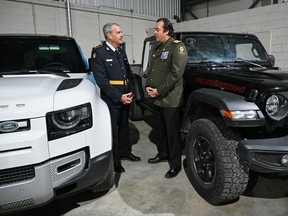Police seized 598 cars from the Port of Montreal destined to be sold abroad.

Article content
There are three ways that thieves can access cars: steal the radio signal of the key fob transmitting to the car, program a new key fob or plug in a device into a USB port to access the car’s onboard computer.
Many of the required devices can be purchased legally. There are even YouTube tutorials to demonstrate how to use them properly. And it all points to how far behind laws and law enforcement are behind the thieves, said officers at the Port of Montreal on Wednesday, where they showed several of the hundreds of cars stolen in Ontario and Quebec and bound for overseas.
Advertisement 2
Article content
Article content
“Currently, it is perfectly legal to buy a key reprogramming device, so we need legislation that does not allow that to happen,” explained Alvaro Almeida, the deputy chief of operations for York Regional Police, in Montreal for the announcement of a major crackdown on auto theft in Canada. “Any steps we can take to ensure that these types of devices are not lawfully sold in Canada would be a step in the right direction.”
Federal legislation preventing car theft is far behind the technology, he said, The last significant legislative change was nearly 20 years ago, when kill switches were mandated in cars sold in this country.
As for what owners can do to prevent car theft, Almeida recommended parking in a garage or a well-lit area and buying a steering wheel-locking device.
The Canada Border Services Agency and Ontario Provincial Police presented the fruits of a joint operation called Project Vector on Wednesday: 598 stolen vehicles recovered in the Port of Montreal between the end of December and the end of March. A total of 390 shipping containers were opened and examined as part of the operation. Several representatives from other police departments were also on hand at the announcement, including Montreal police and the Sûreté du Québec, who regularly work with their counterparts to investigate car theft. No arrests have so far been made related to the car thefts as part of Project Vector.
Article content
Advertisement 3
Article content
Of the cars recovered, 483 were from Ontario; the other 115 were from Quebec. It’s the largest seizure of cars to date and an impressive figure considering 1,200 stolen cars are generally recovered in a single year. Yet, with a car stolen every five minutes in the country, it’s a drop in the bucket, representing just over two days of work for thieves, most of whom are linked to organized crime.
“We look at it from the aspect that we took (more than) $35 million out of the pockets of organized crime,” said Marty Kearns, the deputy commissioner of the OPP. “We’re sending a message that we’re here, we’re active and we’re aware of the problem here in Montreal that cars are being shipped out of country. These are active investigations with all the police services you see here today and we anticipate arrests and charges forthcoming.”
It’s important to put the brakes on car theft because it involves violence, like carjackings.
Although technology has evolved to help track stolen cars, police forces say they still need to work out ways to use that technology to properly find stolen vehicles. For example, a car owner can see an air tag or other device in their car transmitting GPS co-ordinates that indicate the vehicle is in the Port of Montreal, but it remains difficult for police to single out those cars.
Advertisement 4
Article content
That’s a frustration shared by the top brass working to clamp down on vehicle theft, said Annie Beauséjour, a regional director general for the CBSA.
Air tags or other GPS-tracking devices can stay active after a car is stolen, Beauséjour said, adding that an air tag location can be narrowed down to an area as large as 200 metres. In a port where thousands of containers are moved around every day over a large area, that’s not a specific enough location.
“The precise location of them is hard to pinpoint,” she said. “It’s not precise enough to tell us which car is in which container, but we’re trying to come up with ways to be more precise. We’re exploring technology that could allow us to do that.”
Montreal’s port is a hub for cars stolen in Ontario and Quebec. Despite the fact Toronto also has a port, most cars that are stolen in that city are driven to Montreal or packed into rail freight cars and loaded onto ships here because of the destinations served by cargo ships leaving from Montreal.
“They come by train, or are driven to Montreal, because the port serves the European market, so in terms of links to get to Europe, it’s really the Port of Montreal that is used,” Beauséjour said.
In addition to Europe, Kearns said, the vehicles are shipped to buyers in South America, Asia, Africa and the Middle East.
The ports of Halifax and Vancouver also play a role, but it is Montreal’s proximity to Toronto that makes it popular for car thieves.
“Bringing the cars to Halifax is more complicated for thieves,” she said.
Recommended from Editorial
Advertisement 5
Article content
Article content





